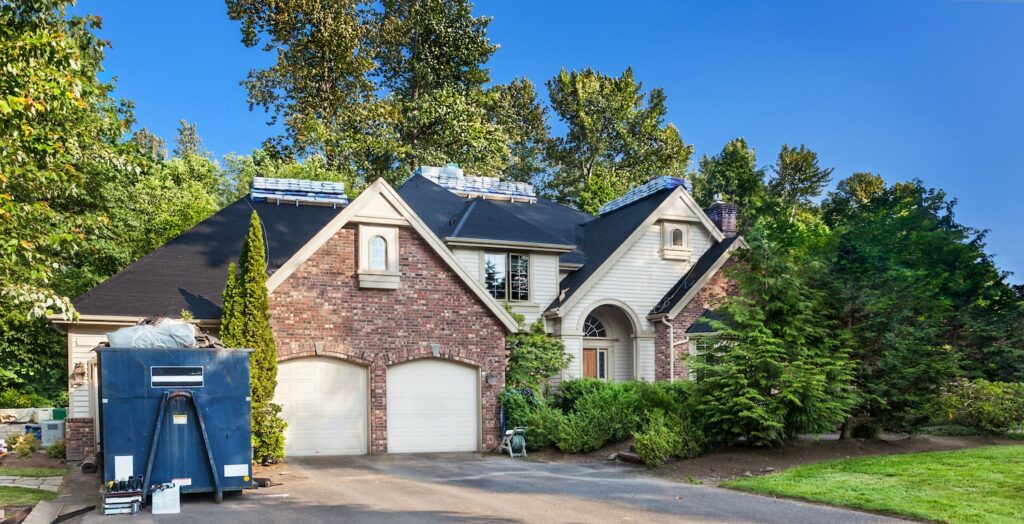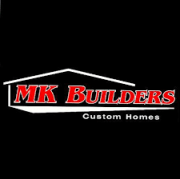In 2022, the average roof replacement cost is $7,211. While it’s not the most expensive renovation you could do to your home, it’s also not the cheapest. So taking the steps toward roof replacement is nothing to take lightly. But we’re here to help you make that decision.
In this guide, we will teach you everything you need to know about roof replacement:
- When to repair vs. replace
- Will insurance cover a new roof?
- The steps involved in roof replacement
- Types of roofs to choose from
- How much does it cost?
- And more.
We’ll also provide some tips for prolonging the life of your roof to get the most out of your investment!
Signs You Need a Roof Replacement
Sadly, your roof is not built to last forever—with the exception of premium roofs like slate and clay tile. But that doesn’t mean you will have to continue replacing your roof for years to come. But more importantly, knowing when the right time to replace it can be a vital step toward getting the most ROI on your new roof.
To the untrained eye, it can be difficult, if not impossible to know when it’s time to replace your roof. While you can assume that living in your home for 20+ years with the roof that was there when you bought it might be a good sign, that’s not the only time it’s appropriate.
There can be other reasons to replace your roof beyond aging beyond its years. If you notice or experience any of the following, you should get a professional inspection to see if repairs or a replacement are in your future.
- Your roof is over 20 years old. While some roofs last far longer, standard asphalt shingle roofs only last 20-30 years, so getting a thorough inspection can determine its condition.
- You can see daylight coming through in your attic. This is likely a sign of a significant hole in the roof, often caused by years of wear and tear. If your roof is in this condition, you will need an entire roof replacement.
- Your energy bills have increased. If you’ve noticed a steady incline in your energy bills with no change in usage, your roof might be to blame. Older roofs are less energy-efficient, so heat and air can escape through the roof if it’s not properly insulated.
- Shingles are missing or damaged. If you’re starting to see bald spots or damaged shingles on your roof, it’s likely because they’ve reached the end of their lifespan and can no longer protect your home from the elements.
- Your roof is sagging. If you see any drooping or sagging on your roof, this is a sure sign that the structure of your roof has been compromised.

When to Repair Vs. Replace
Severe storms can trigger the need to repair your roof when shingles or other portions of your roof are damaged. However, some storms can be severe enough to require a total roof replacement. But how do you know which one is appropriate?
When to Repair Your Roof
If your roof has minor to moderate damage and is less than 15 years old, repairing it will be a fine solution. You can also get by with repairing your roof if:
- Just a few shingles are damaged
- Issues are related to a small leak or poor insulation
- You just installed it a couple of years ago
- You are still under warranty
- If repairs are due to workmanship or manufacturer issues (covered under warranty)
When to Replace Your Roof
On the other hand, a roof replacement is far more extensive and isn’t necessary for all situations. It’s important to note that roof replacements aren’t usually covered under insurance unless it is due to severe storm damage on a roof in good condition. Some situations where replacement is necessary to include:
- You have extensive damage from a natural disaster (tornado, hurricane, hail storm)
- Your roof has reached its expected lifespan (20+ years old)
- You want to increase the value of your home to sell
- You want to invest in an upgraded roofing material
- You simply want to boost curb appeal with a new roof
If your roof is damaged in a storm, it’s critical to get a thorough inspection from a trusted contractor like Apple Roofing. We can determine the best possible solution and whether repairing or replacing is appropriate.
Tips for Getting Insurance to Pay for Your Roof
Your homeowner’s insurance is a necessity to cover damage to your home that happens when you least expect it. It can also cover liability lawsuits, flooded basements, and more. But does it pay for a new roof? It depends.
When your roof is damaged during a storm, you’ll first want to get an inspection, but you’ll also need to file an insurance claim. If you’re worried about insurance denying your claim, you can do a few things to make sure it gets approved.
- Thoroughly read and understand your entire insurance policy. Avoid surprises come claims time and know what your policy does or doesn’t cover.
- Know what coverage to add on when you sign up for insurance. For example, standard insurance policies do not cover damage from floods or hurricanes. Depending on where you live and the likelihood of certain weather events, you will want to add that to your insurance policy.
- Do not put off filing your claim. The longer you wait, the more likely insurance will deny your claim.
- Document the damage. Take pictures or videos of the damage to your roof and keep any receipts for repairs you made prior to filing your claim.
- Get an inspection right away. Just like your claim, don’t put off getting a professional inspection. Knowing the issues early on can ensure your roof is replaced before damage occurs to the rest of your home.
- Do not attempt to make repairs on your own. DIY repairs can often void warranties or make matters worse. If you are hoping for insurance to cover your replacement, don’t attempt to remedy the situation yourself.
- Check your warranties. If you are still under warranty with your roof, don’t go through insurance for replacement. You should reach out to the contractors who installed your roof, or the manufacturer directly to get your replacement covered.
A standard insurance policy will frequently cover roof damages from the following:
- Lightning
- Fire
- Smoke
- Hail
- Wind
- Falling objects/debris
- Freezing
- Vehicles or aircraft
- Collapse from excess weight
- Sudden or accidental pipe bursts, electrical surges, or steam
Typical roof damages NOT covered under a standard insurance policy:
- Earthquakes
- Floods
- Animal or insect infestation
- Regular wear and tear
- Negligence
- Smog
- Corrosion or rust
- Settling from your foundation
Based on the above coverages, the likelihood that insurance will cover a total roof replacement is low. However, paying out of pocket for a roof replacement means a few things.
- You can often get finance options to alleviate the immediate burden
- You’ll get a refreshed manufacturer and workmanship warranty to protect your new roof.
- You boost curb appeal and get an immediate return on investment.

How Much Does a Roof Replacement Cost?
You’re going to dislike our answer, but it depends. Roof replacement costs can depend on a number of factors including:
- The size of your home (the most determining cost factor)
- The type of roofing material installed
- The condition of your existing roof
- The contractor you hire
- How accessible your roof is
The Size of Your Roof
The size of your roof is the number one cost factor in replacing your roof. Obviously, a larger home means more materials and a longer time to replace your roof. The average-sized home in America is around 1,800 square feet, and most roofers will charge by the roofing square (100 sq. feet). So while the average cost is around $8,000, that is based on an average-sized home and can go down or up from there.
Additional Cost for Roofs in Poor Condition
If your old roof tear-off happens and a poorly constructed roofing deck is exposed underneath, this can change things. No good roofer is going to install anything new over the top of a roof that lacks that integrity or structure to uphold your new roof for the extent of its lifespan. Those repairs and reinforcements must take place before the new roof is installed.
Accessibility and Roof Cost
How accessible your roof is can also drive up costs. If your roof is steeply pitched or you have elements of your home that make it difficult to haul or dump materials, this can increase both the time and labor it takes to get the job done. This is something you discuss upon your first meeting and inspection with a new contractor.
Types of Roofing Materials + Their Cost
Standard asphalt shingles are the most commonly used roofing material in the country with nearly 75% of homes today with an asphalt roof. But other roofing material costs are more expensive based on their advanced durability and longer lifespans. Here’s what you can expect to pay for a new roof, by material:
- Asphalt Shingles: $5,000 to 12,500
- Architectural Shingles: $12,000 to $16,000
- Copper Roofing: $22,000 to $45,000
- Corrugated Steel Panels: $10,000 to $19,000
- Cedar Wood Shakes: $14,000 to $25,000
- Clay Tiles: $24,000 to $50,000
- Concrete Tiles: $20,000 to $43,000
- Flat Roof (TPO): $10,000 to $15,000
- Green Roof: $15,000 to $40,000
- Metal Shingles: $11,000 to $15,000
- Rubber Shingles: $9,000 to $14,000
- Slate: $25,000 to $50,000
- Solar Shingles: $60,000 to $75,000
- Standing Seam Metal Roof: $20,000 to $30,000
As you can see, the low end of a new roof can cost $5,000 while the high end can reach $75,000 or more. But with the higher costs you get longer lifespans, stronger materials, better ROI, and fewer replacements throughout the time you own your home.
For example, for every 3 asphalt shingle roofs you install, you install just 1 metal shingle roof. Roof replacements are a great opportunity to upgrade to a more premium roofing material if you are replacing an asphalt shingle roof.
Tips for Upholding Your Roof’s Integrity
After you get your new roof maintaining it to stay in good shape is vital to uphold its integrity, protect your home, and prolong its life (and your investment)
Some roof maintenance tips include:
- Cleaning debris out of your gutters.
- Get your roof professionally cleaned every few years.
- Keeping up with minor roof repairs to prevent leaks.
- Ensure your attic is adequately insulated.
- Removing snow and ice when appropriate.
- Scheduling annual roof inspections.
- Trimming large, overhanging branches.
- Doing a self-inspection after every big storm.
- Paying for a maintenance plan with your local roofer.
How to Get a Proper Roof Replacement
Ultimately, the best way to invest in a new roof is to work with a trustworthy and reputable contractor like Apple Roofing. Our roof replacement process includes thorough inspections, accurate estimates, and above-and-beyond customer service that ensures you have the best possible roofing experience.
Providing our customers with world-class service and high-quality workmanship is what we do best. So when you need a new roof, call Apple Roofing. We will provide you with the best possible solution that ensures you get the most out of your investment.



















